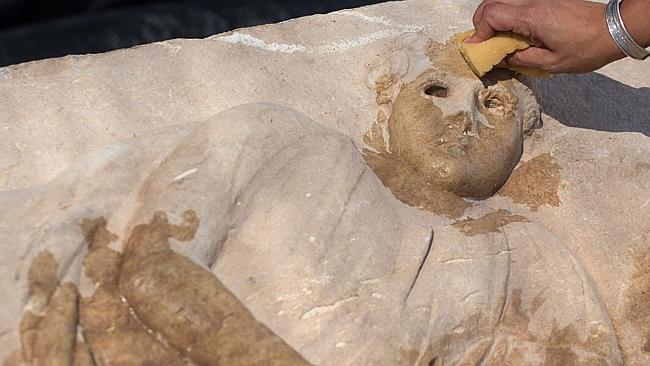AN ELABORATE ancient sarcophagus has been discovered at a building site in the Israeli city of Ashkelon, the Israel Antiquities Authority announced Thursday.
However, the sarcophagus, which is about 1800 years old, was severely damaged when building contractors attempted to remove it improperly from the ground, according to officials.
The Israel Antiquities Authority said that it will take legal action against those involved.
Described as one of the rarest sarcophagi ever discovered in Israel, the stone coffin weighs 2 tons and is 8.2 feet long.
Sculpted on all sides, a life-size figure of a person is sculpted on the sarcophagus’ lid.
“One side of the sarcophagus lid is adorned with the carved image of a man leaning on his left arm,” explained Gabi Mazor, a retired archeologist and expert on the classical periods, in an Israel Antiquities Authority press release.
“He is wearing a short-sleeved shirt decorated with embroidery on the front. A tunic is wrapped around his waist. The figure’s eyes were apparently inlaid with precious stones that have disappeared and the hair is arranged in curls, in a typical Roman hairstyle.”
The other side of the lid features a carved relief of a metal amphora, a vessel used for transporting liquids such as wine, from which there are intertwining tendrils bearing grape clusters and grape leaves.
The sarcophagus is also decorated with wreaths and images of bulls’ heads, naked Cupids, and the head of the mythical creature Medusa.
The sarcophagus, which was apparently excavated last week, was repeatedly struck by a tractor in different places, scarring the stone and damaging the decorations sculpted by on its sides, according to the press release.
“The irreparable damage was caused by contractors who encountered the impressive sarcophagus during the course of their work,” officials explained.
“They decided to hide it, pulled it out of the ground with a tractor while aggressively damaging it, concealed it beneath a stack of sheet metal and boards and poured a concrete floor in the lot so as to conceal any evidence of the existence of the antiquities site.”
“This is an extremely serious case of damage to a rare antiquity of unprecedented artistic, historical and cultural importance,” said Amir Ganor, head of the Israel Antiquities Authority’s Inspection Department.






